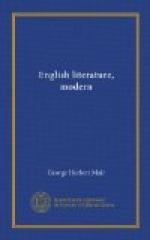The style of Euphues was parodied by Shakespeare and many attempts have been made to imitate it since. Most of them are inaccurate—Sir Walter Scott’s wild attempt the most inaccurate of all. They fail because their authors have imagined that “Euphuism” is simply a highly artificial and “flowery” way of talking. As a matter of fact it is made up of a very exact and very definite series of parts. The writing is done on a plan which has three main characteristics as follows. First, the structure of the sentence is based on antithesis and alliteration; that is to say, it falls into equal parts similar in sound but with a different sense; for example, Euphues is described as a young gallant “of more wit than wealth, yet of more wealth than wisdom.” All the characters in the book, which is roughly in the form of a novel, speak in this way, sometimes in sentences long drawn out which are oppressively monotonous and tedious, and sometimes shortly with a certain approach to epigram. The second characteristic of the style is the reference of every stated fact to some classical authority, that is to say, the author cannot mention friendship without quoting David and Jonathan, nor can lovers in his book accuse each other of faithlessness without quoting the instance of Cressida or Aeneas. This appeal to classical authority and wealth of classical allusion is used to decorate pages which deal with matters of every-day experience. Seneca, for instance, is quoted as reporting “that too much bending breaketh the bow,” a fact which might reasonably have been supposed to be known to the author himself. This particular form of writing perhaps influenced those who copied Lyly more than anything else in his book. It is a fashion of the more artificial kind of Elizabethan writing in all schools to employ a wealth of classical allusion. Even the simple narratives in Hakluyt’s Voyages are not free from it, and one may hardly hope to read an account




